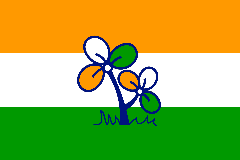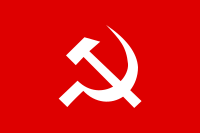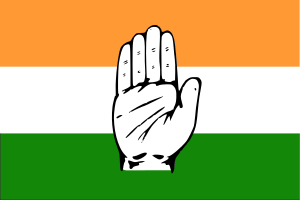Politics of West Bengal
Politics in West Bengal is dominated by the following major political parties: the All India Trinamool Congress, the Bharatiya Janata Party, the Communist Party of India (Marxist), and the Indian National Congress . From a psephological prespective, West Bengal is a hold state where a winning party may continue to win for a considerable amount of time.
In 1977 the Left Front won the state assembly elections, and the state was ruled by communists and allied left groups till 2011. The erstwhile left front led West Bengal state government holds the Indian record for the longest period of governance.
Until 3 November 2000, Jyoti Basu was the Chief Minister of the state. After his resignation, due to health reasons, Buddhadeb Bhattacharjee became the Chief Minister of West Bengal who continued in office until 13 May 2011.
In the run-up to the 2011 elections, the state witnessed several violent clashes between the workers of the opposition parties and the ruling left party cadres.[1]
In the 2011 Assembly Election, the Trinamool Congress- Indian National Congress alliance won by a huge margin with Mamata Banerjee becoming the first woman chief minister of West Bengal after 34 years of Communist rule.
In the 2016 Election, Congress and Left Front formed an alliance, and the election witnessed a three-way contest between their alliance, Trinamool Congress, and BJP.
Government
West Bengal is governed through a parliamentary system of representative democracy, a feature the state shares with other Indian states. Universal suffrage is granted to residents. There are two branches of government. The legislature, the West Bengal Legislative Assembly, consists of elected members and special office bearers such as the Speaker and Deputy Speaker, who are elected by the members. Assembly meetings are presided over by the Speaker or the Deputy Speaker in the Speaker's absence. The judiciary is composed of the Calcutta High Court and a system of lower courts. Executive authority is vested in the Council of Ministers headed by the Chief Minister although the titular head of government is the Governor. The Governor is the head of state appointed by the President of India. The leader of the party or coalition with a majority in the Legislative Assembly is appointed as the Chief Minister by the Governor, and the Council of Ministers are appointed by the Governor on the advice of the Chief Minister. The Council of Ministers reports to the Legislative Assembly. The Assembly is unicameral with 295 Members of the Legislative Assembly, or MLAs,[2] including one nominated from the Anglo-Indian community. Terms of office run for five years, unless the Assembly is dissolved prior to the completion of the term. Auxiliary authorities known as panchayats, for which local body elections are regularly held, govern local affairs. The state contributes 42 seats to the Lok Sabha[3] and 16 seats to the Rajya Sabha of the Indian Parliament.[4]
History
The area's early history featured a succession of Indian empires, internal squabbling, and a tussle between Hinduism and Buddhism for dominance. Ancient Bengal was the site of several major Janapadas (kingdoms), while the earliest cities date back to the Vedic period. The region was part of several ancient pan-Indian empires, including the Mauryans and Guptas. It was also a bastion of regional kingdoms. The citadel of Gauda served as the capital of the Gauda Kingdom, the Buddhist Pala Empire (eighth to 11th century) and Hindu Sena Empire (11th–12th century). From the 13th century onward, the region was ruled by several sultans, powerful Hindu states, and Baro-Bhuyan landlords, until the beginning of British rule in the 18th century. The British East India Company cemented their hold on the region following the Battle of Plassey in 1757, and Calcutta served for many years as the capital of British India. The early and prolonged exposure to British administration resulted in an expansion of Western education, culminating in developments in science, institutional education, and social reforms in the region, including what became known as the Bengali Renaissance. A hotbed of the Indian independence movement through the early 20th century, Bengal was divided during India's independence in 1947 along religious lines into two separate entities: West Bengal, a state of India, and East Bengal, a province of Pakistan which later became independent Bangladesh.
Bidhan Chadra Roy Era (1947–1962)
Princely state merge with West Bengal
In 1950, the Princely State of Koch Bihar merged with West Bengal after King Jagaddipendra Narayan had signed the Instrument of Accession with India.[5] In 1955, the former French enclave of Chandannagar, which had passed into Indian control after 1950, was integrated into West Bengal. Portions of Bihar were subsequently merged with West Bengal.
During Roy's Chief Minister-ship very few manufacturing industries were set up in the state. In 1954, when Dr. B. C. Roy was the Congress chief minister, a massive food crisis overtook the state. There was a near-famine condition in Bengal.
United Front (1967)
1967 General Election
After the state legislative elections held in 1967, the CPI(M) was the main force behind the United Front government formed. The Chief Ministership was given to Ajoy Mukherjee of the Bangla Congress.
Naxalbari uprising
In 1967 a peasant uprising broke out in Naxalbari, in northern West Bengal. The insurgency was led by hardline district-level CPI(M) leaders Charu Majumdar and Kanu Sanyal. The Naxalbari movement was violently repressed by the West Bengal government. During the 1970s and 1980s, severe power shortages, strikes and a violent Marxist-Naxalite movement damaged much of the state's infrastructure, leading to a period of economic stagnation.
The Bangladesh Liberation War of 1971 resulted in the influx of millions of refugees to West Bengal, causing significant strains on its infrastructure.[6] The 1974 smallpox epidemic killed thousands. West Bengal politics underwent a major change when the Left Front won the 1977 assembly election, defeating the incumbent Indian National Congress. The Left Front, led by Communist Party of India (Marxist), has governed for the state for the subsequent three decades.[7]
Dismissal of United Front government
In November 1967, the West Bengal United Front government was dismissed by the central government. Initially the Indian National Congress formed a minority government led by Prafulla Chandra Ghosh, but that cabinet did not last long. Following the proclamation that the United Front government had been dislodged, a 48-hour hartal was effective throughout the state. After the fall of the Ghosh cabinet, the state was put under President's Rule.
1969 Assembly election
Fresh elections were held in West Bengal in 1969. CPI(M) emerged as the largest party in the West Bengal legislative assembly.[8] But with the active support of CPI and the Bangla Congress, Ajoy Mukherjee was returned as Chief Minister of the state. Mukherjee resigned on March 16, 1970 and the state was put under President's Rule.
Shiddharthrasankar Ray Era (1972–1977)
Indian National Congress won the 1972 assembly election, and its leader Siddhartha Shankar Ray became the chief minister. During this period, the then Prime Minister of India, Indira Gandhi proclaimed nationwide Emergency in 1975.
This period was marked by large scale violence as the police force battled with the naxalites and ultimately crushed the movement in the state.
Left Front era
Jyoti Basu (1977–2000)
1977 Election
In the 1977 election of the state legislature, the Left Front, headed by Communist Party of India (Marxist), won 243 seats thereby gaining a majority. The first Left Front government was established with Jyoti Basu as the Chief Minister.
Marichjhanpi Massacre, 1979
The massacre in Marichjhanpi, which took place under CPI(M) rule in Bengal between January 26 and May 16, 1979, relates to the forcible eviction of refugees who had fled from East Pakistan thereby leading to the death of a sizable population among them.[9]
Out of the 14,388 families who deserted [for West Bengal], 10,260 families returned to their previous places … and the remaining 4,128 families perished in transit, died of starvation, exhaustion, and many were killed in Kashipur, Kumirmari, and Marichjhapi by police firings (Biswas 1982, 19).[10][11]
After leading the Left Front government for consecutive five terms, Jyoti Basu retired from active politics and Buddhadeb Bhattacharjee was appointed as his successor. Five years later, the Left Front came back to the power with Bhattacharjee again assuming the office of the Chief Minister.[9]
Budhdhadev Bhattacharya (2000–2011)
The state's economic recovery gathered momentum after economic reforms in India were introduced in the early 1990s by the central government, aided by election of a new reformist Chief Minister Buddhadeb Bhattacharya in 2000. As of 2007, armed activists have been organizing terrorist attacks in some parts of the state,[12][13] while clashes with the administration have taken place at several sensitive places on the issue of industrial land acquisition.[14][15]
Nandigram violence
The Nandigram violence was an incident in Nandigram, West Bengal where, on the orders of the Left Front government, more than 4,000 heavily armed police stormed the Nandigram area with the aim of stamping out protests against the West Bengal government's plans to expropriate 10,000 acres (40 km2) of land for a Special Economic Zone (SEZ) to be developed by the Indonesian-based Salim Group. The police shot dead at least 14 villagers and wounded 70 more.
The SEZ controversy started when the government of West Bengal decided that the Salim Group of Indonesia[16][17][18] would set up a chemical hub under the SEZ policy at Nandigram, a rural area in the district of Purba Medinipur. The villagers took over the administration of the area and all the roads to the villages were cut off. A front-page story in the Kolkata newspaper, The Telegraph, on 4 January 2007 was headlined, "False alarm sparks clash". According to the newspaper that village council meeting at which the alleged land seizure was to be announced was actually a meeting to declare Nandigram a "clean village", that is, a village in which all the households had access to toilet facilities.
Trinamool Congress era
In the 2011 West Bengal Legislative Assembly election, Left Front was defeated and Trinamool Congress won an absolute majority of seats. Mamata Banerjee, the leader of Trinamool Congress, became the chief minister. The success of Trinamool Congress was repeated in the 2013 Panchayat election (local government elections in rural areas, and some urban municipalities) and the 2014 Indian general election (in which Trinamool won 24 of 42 Lok Sabha constituencies in the state).
Major political parties of West Bengal
 Trinamool Congress
Trinamool Congress

See also
| Wikimedia Commons has media related to Politics of West Bengal. |
- Government of West Bengal
- Chief Minister of West Bengal
- List of political parties in West Bengal
- Political parties of West Bengal
Notes and references
- http://www.indianexpress.com/news/maoist-didi-party-lists-of-armed-cpm-camps-are-almost-identical/680582/0
- "West Bengal legislative assembly". Legislative bodies in India. National Informatics Centre, India. Archived from the original on 13 March 2016. Retrieved 28 October 2006.
- Delimitation Commission (15 February 2006). "Notification: order no. 18" (PDF). New Delhi: Election Commission of India. pp. 23–25. Archived from the original (PDF) on 13 August 2011. Retrieved 11 February 2012.
- "Composition of Rajya Sabha" (PDF). Rajya Sabha at work. New Delhi: Rajya Sabha Secretariat. pp. 24–25. Archived from the original (PDF) on 5 March 2016. Retrieved 15 February 2012.
- Dr. Sailen Debnath, ed. Social and Political Tensions In North Bengal since 1947, ISBN 81-86860-23-1.
- (Bennett & Hindle 1996, pp. 63–70)
- Biswas, Soutik (2006-04-16). "Calcutta's colourless campaign". BBC. Retrieved 2006-08-26.
- Indian National Congress had won 55 seats, Bangla Congress 33 and CPI 30. CPI(M) allies also won several seats.ECI: Statistical Report on the 1969 West Bengal Legislative Election Archived 29 November 2007 at the Wayback Machine
- Bhattacharya, Snigdhendu (25 April 2011). "Ghost of Marichjhapi returns to haunt". The Hindustan Times. Archived from the original on 10 June 2015. Retrieved 5 August 2013.
- Ross, Mallick. "The Morichjhanpi massacre: When tigers became citizens, refugees "tiger-food"" (PDF).
- "Remembering Marichjhapi Massacre, 1979". insightyv.com. Archived from the original on 7 July 2009. Retrieved 16 May 2010.
- Ghosh Roy, Paramasish (22 July 2005). "Maoist on Rise in West Bengal". VOA Bangla. Voice of America. Archived from the original on 12 December 2007. Retrieved 11 September 2006.
- "Maoist Communist Centre (MCC)". Left-wing Extremist group. South Asia Terrorism Portal. Retrieved 2006-09-11.
- "Several hurt in Singur clash". rediff News. Rediff.com India Limited. 28 January 2007. Retrieved 2007-03-15.
- "Red-hand Buddha: 14 killed in Nandigram re-entry bid". The Telegraph. 15 March 2007. Retrieved 2007-03-15.
- For more information on the Salim Group please see Sudono Salim
- Asia Week
- Far Easter Economic Review October 1998